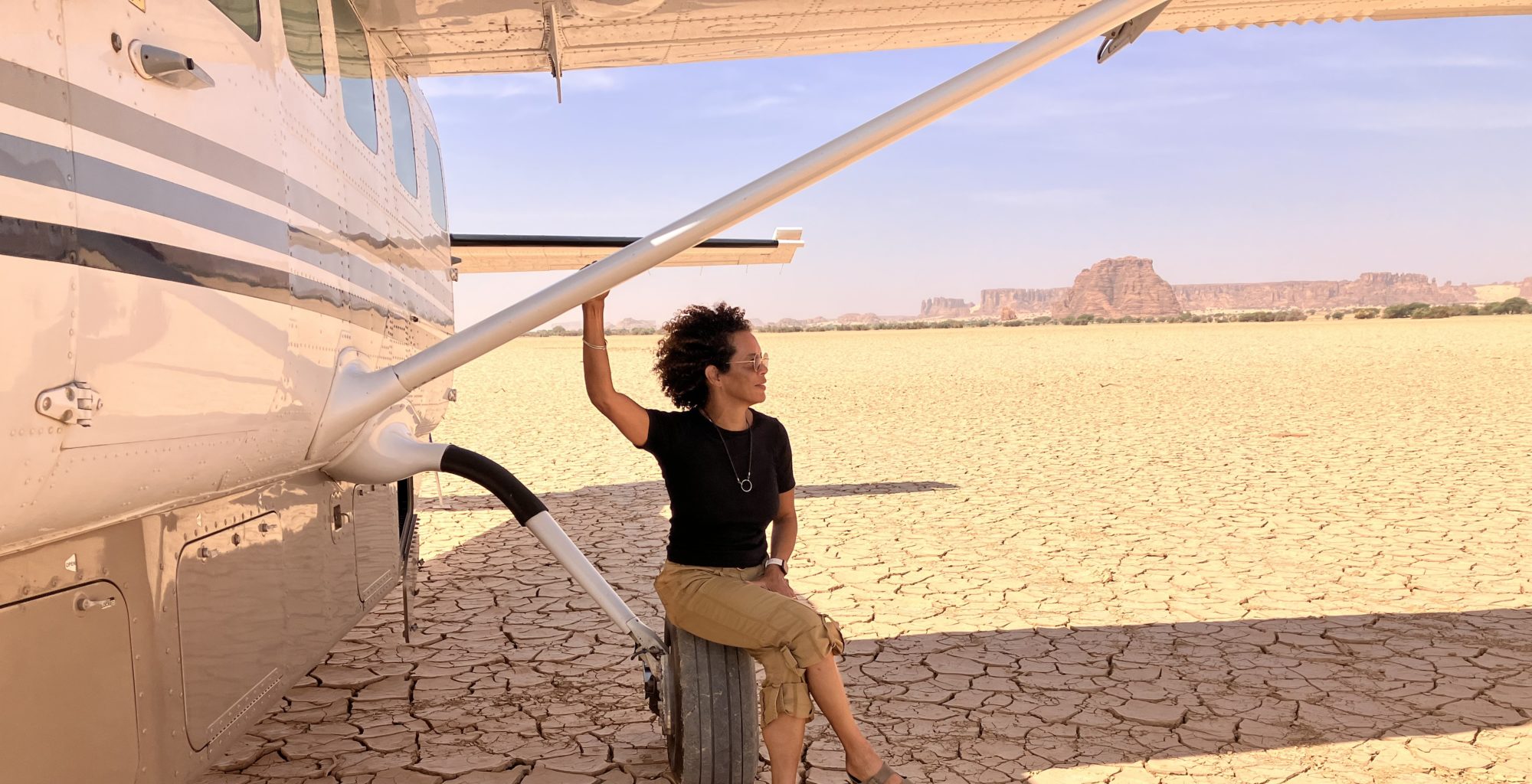Dave Waddell speaks with writer Aminatta Forna off the back of her recently published story in Conde Nast Traveler, which takes us to the desert scape of the Ennedi Massif in northeastern Chad. They discuss emptiness, the nature of deep time, and freedom. A truly original thinker, Forna’s way of seeing — and of conveying that seeing — makes for a beautifully engaging conversation. Her trip was organised by Will Jones and joined by the photographer Alistair Taylor-Young.
How and why did you end up travelling to Chad with Will Jones and Alistair Taylor-Young?
I’d been in conversation for a little while with the features editor at Conde Nast Traveler magazine, who was looking for writers to write essays for the magazine. I told her I was interested in the wilds of Africa more than anything else. It also chimes with a book I’m working on about the Great African Rift Valley, which has taken me to desert-scapes and to some other quite astonishing landscapes. I was in that space of writing about those kinds of places. I also knew the other Sahara, the Malian side, very well. So, Lydia [Bell] called me and asked if I would be willing to go to Chad. I immediately said yes. There was a moment of worry, because when things blew up in Sudan, of course, a lot of the refugees were going across that border. I spoke with Will [Jones] and felt comforted by the fact that I was in the hands of an experienced traveller and someone who took that kind of information gathering and preparation seriously. And so off we went.
You landed in N’Djamena and then travelled north, so presumably far away from the knock-on effects of the situation in Sudan, given that they are felt on the southeast borders of Chad?
They’re on the east side. If you look on a map, it looks like it’s relatively nearby. But the distances in Chad are so enormous, and that’s what I hadn’t really got my head around. I remember when I moved to the States, I had to adjust my sense of scale. I’d look at the map and think that it was only half an hour away because I was looking with my small island brain. We’d then get in the car and drive for five hours. That’s what the Sahara is like. What looks like it’s near on the map is actually many thousands of miles away. We were nowhere near the unrest. Having said that, we did see a lot of aid agency people arriving. Chad is very much the heart of that refugee operation.
As mentioned, I know the Malian side better. I was once a BBC reporter and was sent to cover a war there between the Tuaregs and the Malian army in the 90s. That war is still going on, and now, unfortunately, Mali’s become impassable. Chad is the new destination. Compared to everywhere else, Chad is very peaceful. The army, from everything I was told and everything I heard, is disciplined and effective, and has been a large part of the peacekeeping forces in the area. I didn’t feel at any time in any danger.
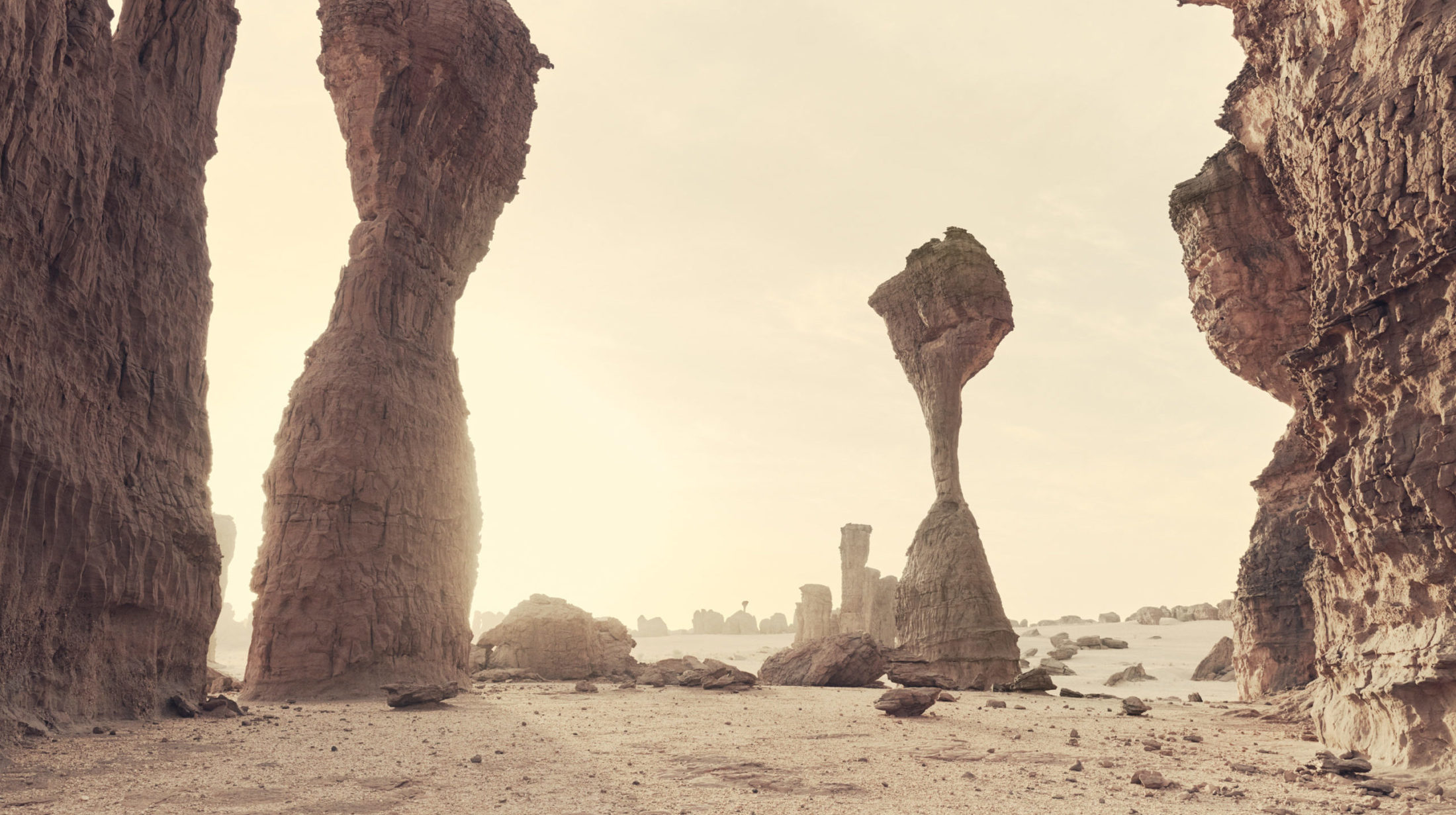
Ennedi Massif, Chad © Alistair Taylor-Young
There are many types of time: contemporary time, family time, sacramental time, ancestral time, and childhood time. You speak in the piece about deep time and share an analogy to illustrate how that time comes about and is felt. The analogy: ‘When I was a child, a teacher tried to give my class some sense of eternity. Imagine a rock 10,000 miles by 10,000 miles. Every 10,000 years a small bird comes and wipes its beak this way and that upon the rock. Deep time, Earth time, captures the entire process of erosion, until the rock is finally worn away.’ Can you share with us more about that deep time and what it is about the Ennedi Massif that is this and not other times?
It’s clear from being in the Ennedi Massif that it is not contemporary time. I think that much is evident. There’s very little sign of modern life. So, the sense of timelessness that this is life as it’s always been lived or at least it’s been lived for thousands of years, is very evident. It’s evident —when you look at the cave paintings and how people are living there now— that they’re not that far apart.
I’ve spent the last two years immersed in deep time because I’ve been exploring the African Rift Valley and talking to palaeontologists, ecologists, and even astrobiologists about their work. But to go to a place like the Ennedi, to speak to people like that, to explore those kinds of worlds and that way of thinking… It is simply to enter a different dimension. It’s easy to feel very, very small. It’s also very easy to feel insignificant and extremely transient. While not in the Ennedi, but in Ethiopia, is this thought I had when looking at a skull dating four and a half million years old: that if that was just a blink in time, in terms of the billions of years earth has existed, then I am a blink in a blink in a blink in a blink in a blink in a blink the eye of time.
Now, one can go away with two thoughts. One is of insignificance. But the other thought I take from it is the idea of majesty. The world is greater than we are. I take great comfort from that. To look at a landscape like the Ennedi, where there’s evidence —like the shells in the sand— of oceans having been there. This to me was miraculous. It’s such an extraordinary idea. So, that’s what I mean by deep time; the feeling that is produced in one by travelling through the Ennedi.
I think children have that sense of awe. When I was a kid, I used to do things like stare at the stars and wonder what was up there, and then you grow up and you get bogged down in reality and you’re more worried about your tax return than you are about what else is outside in the universe, I always remember the impossibility of getting your mind around anything that felt like eternity. According to a palaeontologist I spoke to, most of us can imagine back about a hundred thousand years and then the imagination just fails, and we can’t get back any further.
So, the analogy that came to mind—which I remembered hearing from my geography teacher—is the best one to date to describe what eternity feels like. He was an extremely inspirational teacher. I’ve never forgotten him, and I’ve never forgotten that particular description.
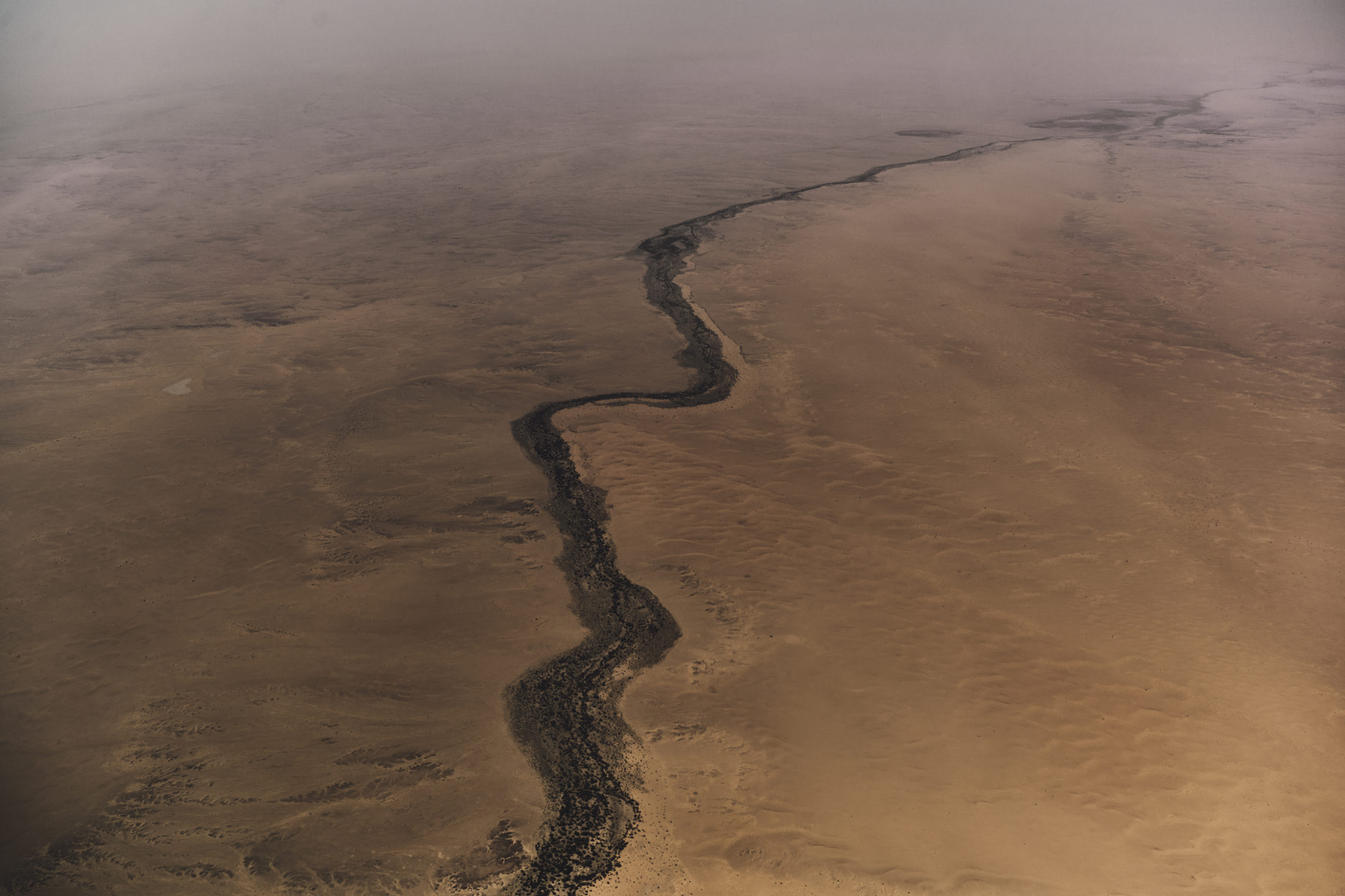
View from the air, trees line the course of a seasonal river
I love how you—explicitly and implicitly—contrast the massiveness of the desert and the forces that have shaped it with the tiny details of the life it holds, whether that’s the ‘tear-shaped tracks of a lizard’ or a wind that is both scentless and faint. At one point, you say: ‘I have traveled to many deserts, but as I lay in bed in the open air and gazed directly into the face of the moon, it was clear to me that the Ennedi was the emptiest landscape I had ever experienced.’ Is this how this landscape spoke to you, in extremes, as very large and very small, the rub between the two an expression of that emptiness?
I guess it’s easy to look at a landscape like the Ennedi and think it’s empty. I have a great love of wildlife and when I was told there was wildlife there, I was very keen to see it. It then became apparent that I wasn’t going to see very much of it because it’s scarce and mostly nocturnal. But that first night, I was told there was a hyena that wandered through the camp on the way to his lair. I have a great interest in and fondness for hyenas, and so I went out to look for its tracks. I’d also taken an ultraviolet torch with me as I had just done a trip to Turkana. I was warned that there were a lot of scorpions in Turkana and turns out that black light torches illuminate scorpions.
So, Alistair [Taylor-Young, accompanying photographer] and I went around looking that first night, a bonding moment really, for scorpions. We found one almost immediately, a small one scuttling under a rock. I then began to think if I’m going to look for wildlife, I’m going to have to look in a very different way. But also, because the sand is so perfectly smooth, with the wind blowing away the top layer every single evening or morning, you wake up to a renewed canvas that is utterly smooth — apart from the tracks of everything that’s gone on that night, all the activity that had taken place while we were asleep.
That was one of my interests. The other one was: Where do you look? As a writer, I think of ways of seeing, and people have different ways of seeing. At one point, Will asked whether I had a way into this article. I was finding it a little hard to think about how I would approach it and replied: Well at the moment, it’s look up, look down, look up, look down. He asked me to explain and I said: Well, you look up and you see all of that, then you look down and you can see another world, which is the world in which these tiny creatures are living, that for them looking up, it was just the nearest rock or us standing there. It was just that extraordinary sense of scale that I wanted to draw on.
I noted that sense of scale in something that Rocco [Ravà, owner and guide of SVS Chad] told me on the trip. He said, there’s a reason that the world’s greatest religions—Islam, Judaism, Christianity—have all been founded in desert countries. It is that sense of wonder and that sense of awe.
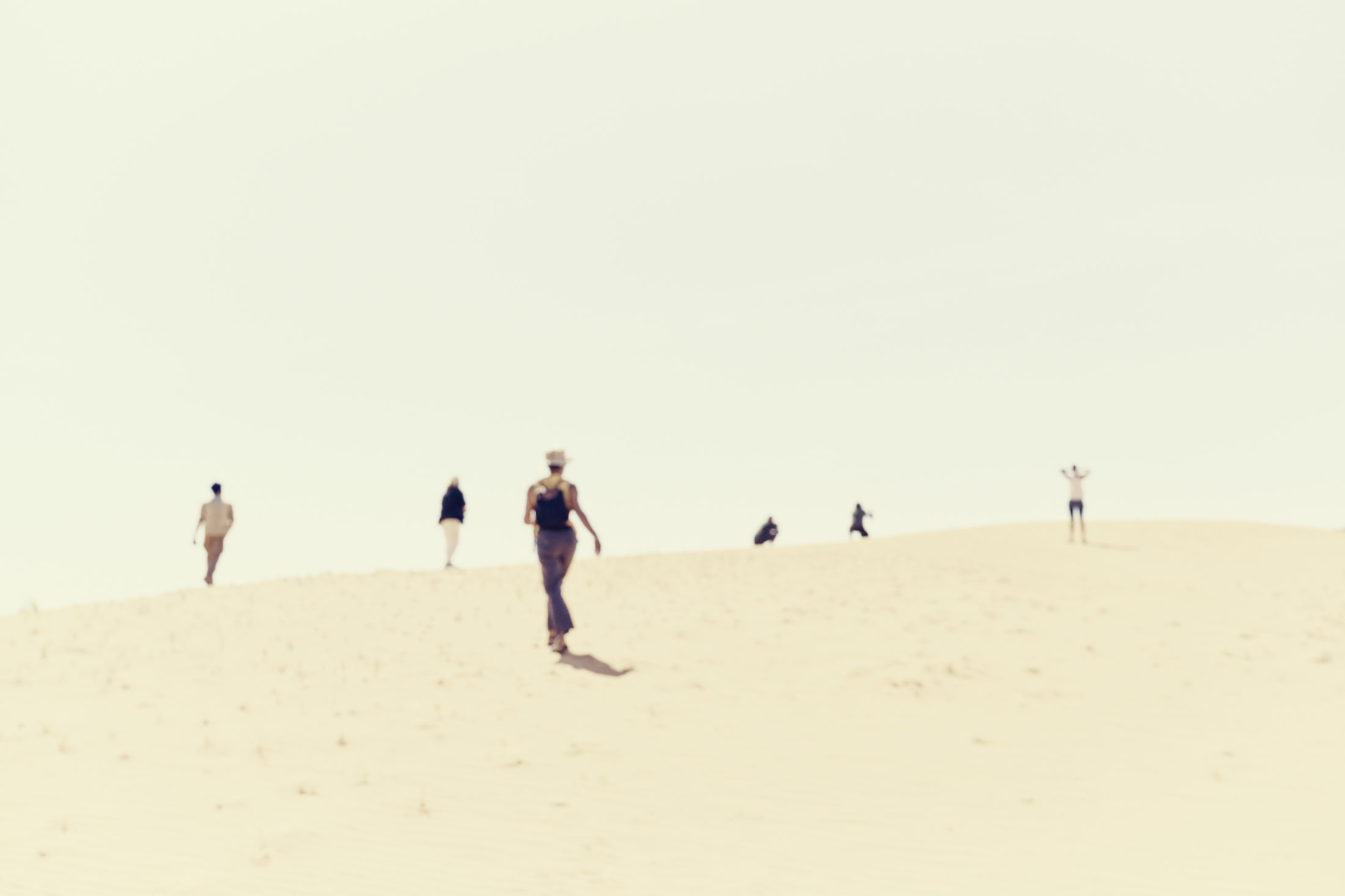
Streching legs during an excursion to the fly camp at Achouili
At one point you saw apes and elephants in the rocks. Is there something about the desert, and especially this desert, that makes it hallucinatory?
You must completely recalibrate your senses. Did I feel that it was hallucinatory? Well yes, it was definitely surreal. One of the things that was so extraordinary was driving from base camp and up to the fly camping, and there we would be apparently in the middle of nowhere with nothing and then there would be these beautiful rock paintings. So, one really had to be open to all kinds of experiences.
Another thing that frequently came up [when discussing itineraries] was whether or not a helicopter could land here or there. I would have thought that would be utterly disorienting for a traveller to try to look at that landscape like that. I think one of the most important things we did was to drive through it. It would have been nice to have driven all the way from N’Djamena to the Ennedi, because then you would enter it in slow time: you would be slowly immersed into it. As it was, we flew into it, but we flew reasonably low and probably because I’ve flown over the Sahara so many times, I didn’t find that particularly disorienting—in fact, I found it enchanting. Then to land and the first view was of the base camp, which is in this great box canyon and the tents look tiny; that was the first time I had to adjust my sense of scale. But because we drove over land all the rest of the way, it became more and more possible to accustom oneself to that sense.
I think for the apes and elephants, well that’s just because I’m still kind of a kid. I don’t seem to have done an awful lot of growing up and it was just kind of like how you look at clouds and see the different shapes. I’d also been told that there were baboons on the top of the cliffs, and so I was looking for baboons, and then gradually we all became aware that these rocks had certain shapes. This is partly how the people who navigate through the desert begin to look at the landscape: they know what the rocks look like.
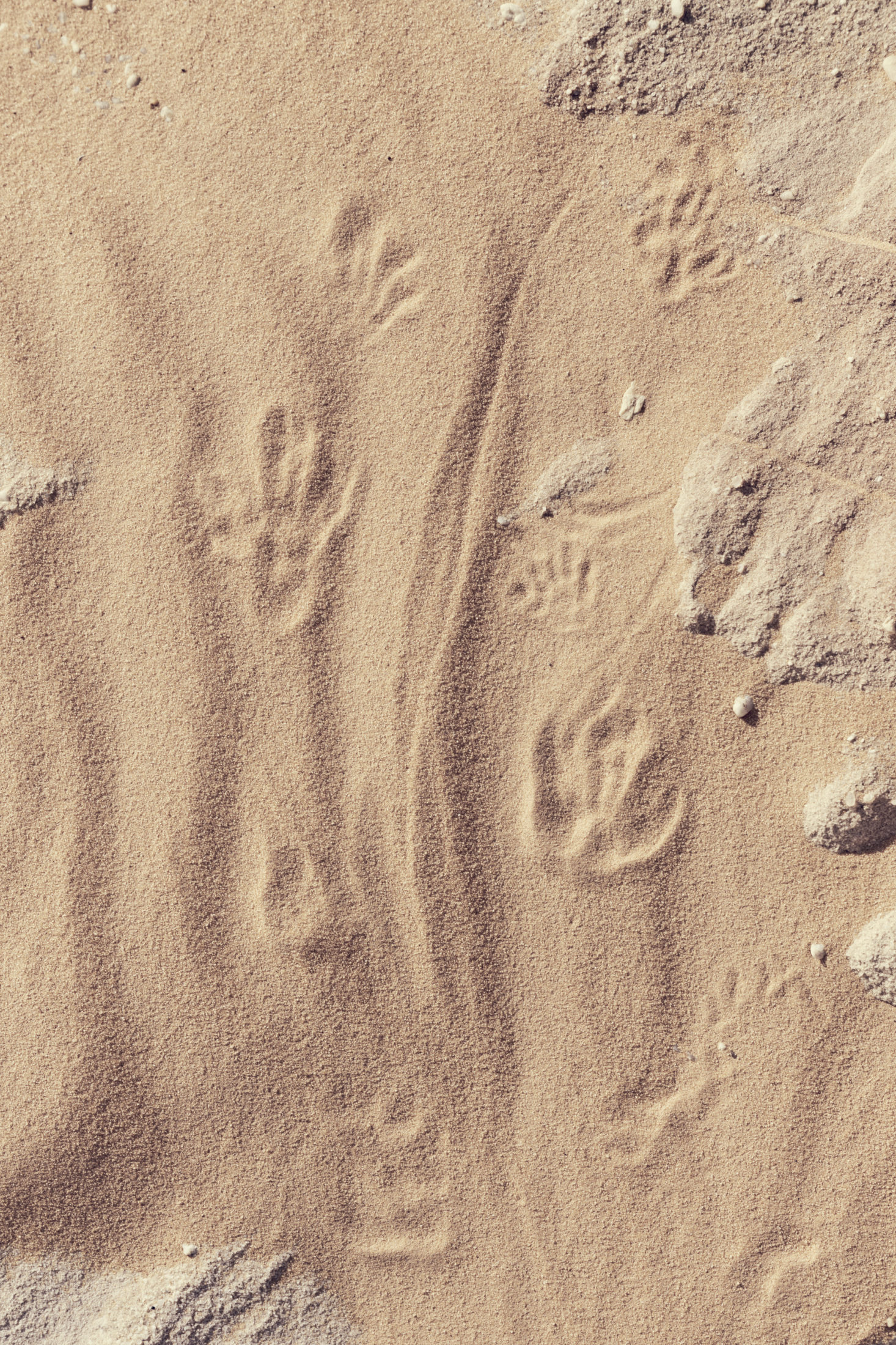
Lizzard tracks in the desert
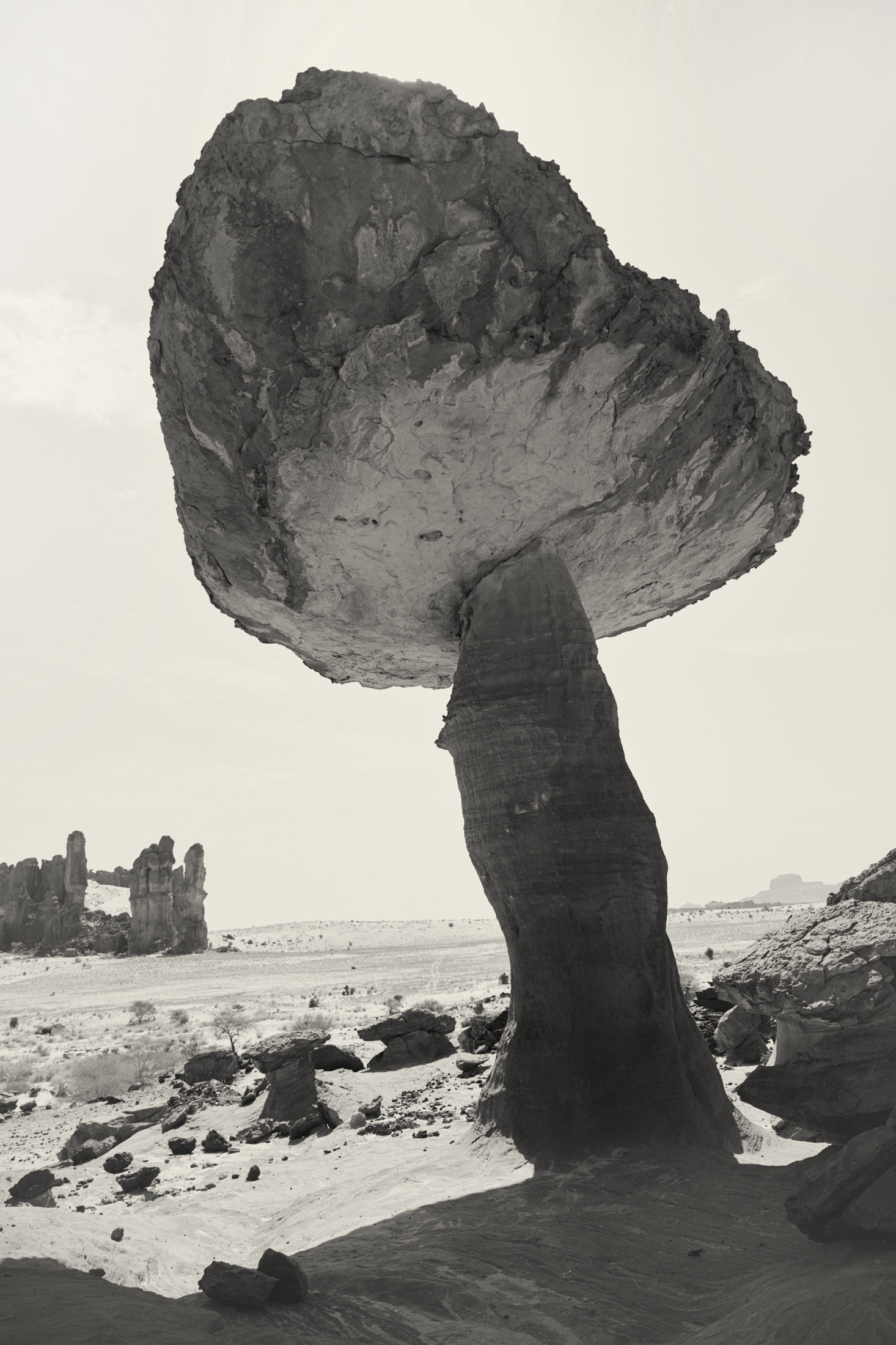
Mushroom of Chigeou
You describe the four remaining crocodiles of Guelta d’Archei as the most arresting of the desert’s ‘ancient wonders’ and as a ‘relic of time’. They are considered sacred and three of the four are female, the sex of the fourth is unknown. Reading your account, I feel all sorts of things—wonder, despair, fascination, sadness. Does any of this resonate or was it different for you?
The strange thing is they’ve been there so long that something has obviously been working for them. I believe that the story is that they were left behind when that place was sea. I can’t think how else they how else they got there. The idea [believed by those who consider them sacred] is that when they disappear, so will the water. I’ve spent a lot of time studying and reading and writing about the mythologies of Africa, which have a lot in common with other early mythologies, like those of the native Americans, and what’s evident is that they’re all related to conservation and ecology. So yes, it makes sense that the two things herald each other: the disappearance of the crocodile and the disappearance of the water.
You end the piece talking about freedom. What is freedom and why ‘in our world’ do we have ‘only the faintest idea’ of what it ‘can mean’?
In our world, we’re obsessed with a certain kind of freedom and that is free will. It is the autonomy that we can do what we want, be what we want, and go where we want. The way we mostly go about achieving this is from financial gain, which anyone who’s ever really tried to make a lot of money (which I haven’t done) will realise really doesn’t amount to much. In the Ennedi, you are subject to all kinds of constraints in order to stay alive and yet, at the same time, you are free of other kinds of constraints. I mean you are literally free to choose between life and death, but you are free of the burden of contemporary society and I think that freedom is something very rarely felt. For us, we get it once in a lifetime, by going somewhere like the Ennedi.
A big thank you to Aminatta for taking the time to discuss the Ennedi. If anything covered has piqued your interest, please do get in touch. If you’ve not already, do have a read of ‘Sands of Time‘. It’s a beautiful piece of travel journalism. For much more on Aminatta and her writing, see her website.
